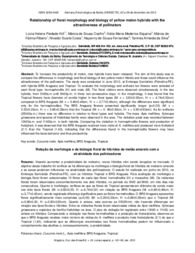Relationship of floral morphology and biology of yellow melon hybrids with the attractiveness of pollinators.
Relationship of floral morphology and biology of yellow melon hybrids with the attractiveness of pollinators.
Author(s): KIILL, L. H. P.; COELHO, M. de S.; SIQUEIRA, K. M. M.; RIBEIRO, M. de F.; COSTA, N. D.; FERNANDES, N. de S.; SILVA, T. A. da
Summary: To increase the productivity of melon, new hybrids have been released. The aim of this study was to c ompare the differences in morphology and floral biology of two yellow melon hibrids and these could influence the attractiveness of the pollinators. The study was conducted in June 2010, at Embrapa Semiárido (Petrolina-PE), with hybrids BRS Araguaia and Tropical. To evaluate the morphology and anthesis ten flowers were selected of each floral type: hermaphrodite (H) and male (M). The floral visitors were observed simultaneously in the two hybrids, from 5h00a.m until 6h00p.m, in three non-consecutive days. In the morphology, it was found that the Tropical flowers have diameter of corolla higher in two floral types (M: x = 3.82±0.55cm, H: x = 4.74±0.52cm) compared to BRS Araguaia (M: x = 3.46±0.46cm, H: x = 3.77±0.45cm), although the differences were significant only for the hermaphrodites. The BRS Araguaia flowers presented significantly longer (p<0.05) (M: x = 2.20±0.23cm, H: x = 3.86±0.39cm) that the Tropical (M: x = 0. 96±0.30cm, H: x = 2.60±0.63cm). As for anthesis (05h30a.m.) there was no difference in relation to floral types and hybrids. The bees Apis mellifera, Xylocopa grisescens and species of Halictidae family were observed in the area. The visitation peak was recorded between 10h00a.m. and 11h00a.m. in both hybrids. Comparing the visitation in hermaphrodite flowers and production of fruit/plant, it was observed that the BRS Araguaia received more visits of A. mellifera and produced more fruit/plant (2.1) than the Tropical (1.43), indicating that the differences found in the hermaphrodite flowers may have influenced the bees behavior and thus productivity.
Publication year: 2012
Types of publication: Journal article
Unit: Embrapa Semi-arid Region
Keywords: Abelha, Apis Mellifera, Biologia floral, Cucumis Melo, Melão, Natural resource, Polinização, Recurso natural
Observation
Some of Embrapa's publications are published as ePub files. To read them, use or download one of the following free software options to your computer or mobile device. Android: Google Play Books; IOS: iBooks; Windows and Linux: Calibre.
Access other publications
Access the Agricultural Research Database (BDPA) to consult Embrapa's full library collection and records.
Visit Embrapa Bookstore to purchase books and other publications sold by Embrapa.

